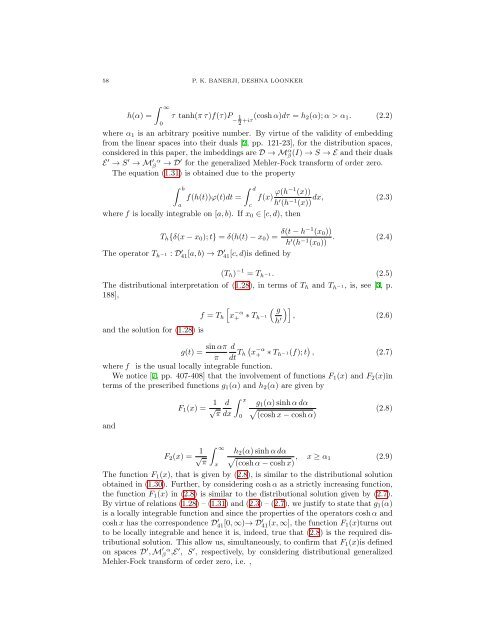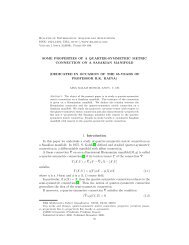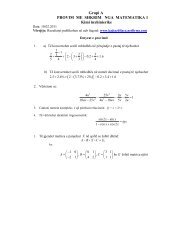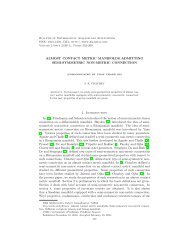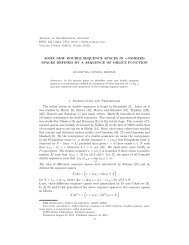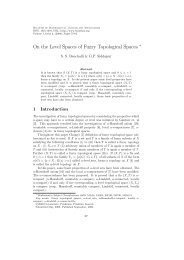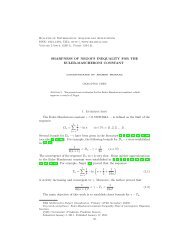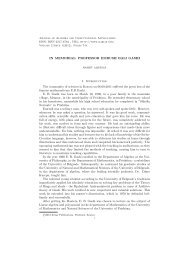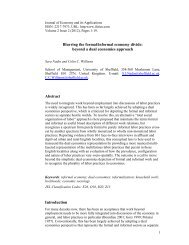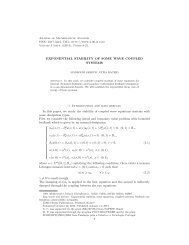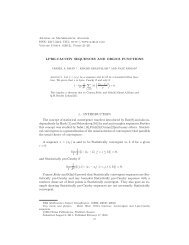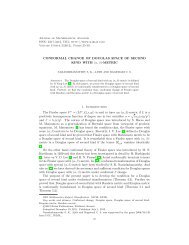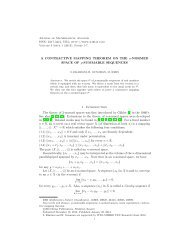DUAL INTEGRAL EQUATIONS INVOLVING LEGENDRE ...
DUAL INTEGRAL EQUATIONS INVOLVING LEGENDRE ...
DUAL INTEGRAL EQUATIONS INVOLVING LEGENDRE ...
You also want an ePaper? Increase the reach of your titles
YUMPU automatically turns print PDFs into web optimized ePapers that Google loves.
58 P. K. BANERJI, DESHNA LOONKER<br />
∫ ∞<br />
h(α) = τ tanh(π τ)f(τ)P 1 (cosh α)dτ = h −<br />
2(α); α > α 1 . (2.2)<br />
0<br />
2 +iτ<br />
where α 1 is an arbitrary positive number. By virtue of the validity of embedding<br />
from the linear spaces into their duals [2, pp. 121-23], for the distribution spaces,<br />
considered in this paper, the imbeddings are D → M α β<br />
(I) → S → E and their duals<br />
E ′ → S ′ → M ′ β α → D ′ for the generalized Mehler-Fock transform of order zero.<br />
The equation (1.31) is obtained due to the property<br />
∫ b<br />
∫ d<br />
f(h(t))ϕ(t)dt = f(x) ϕ(h−1 (x))<br />
a<br />
c h ′ (h −1 dx, (2.3)<br />
(x))<br />
where f is locally integrable on [a, b). If x 0 ∈ [c, d), then<br />
T h {δ(x − x 0 ); t} = δ(h(t) − x 0 ) = δ(t − h−1 (x 0 ))<br />
h ′ (h −1 (x 0 )) . (2.4)<br />
The operator T h −1 : D 41[a, ′ b) → D 41[c, ′ d)is defined by<br />
(T h ) −1 = T h −1. (2.5)<br />
The distributional interpretation of (1.28), in terms of T h and T h −1, is, see [3, p.<br />
188],<br />
[ ( g<br />
)]<br />
f = T h x −α<br />
+ ∗ T h −1<br />
h ′ , (2.6)<br />
and the solution for (1.28) is<br />
sin απ d<br />
g(t) =<br />
π dt T (<br />
h x<br />
−α<br />
+ ∗ T h −1(f); t ) , (2.7)<br />
where f is the usual locally integrable function.<br />
We notice [7, pp. 407-408] that the involvement of functions F 1 (x) and F 2 (x)in<br />
terms of the prescribed functions g 1 (α) and h 2 (α) are given by<br />
and<br />
F 1 (x) = √ 1 ∫<br />
d x<br />
g 1 (α) sinh α dα<br />
√ (2.8)<br />
π dx 0 (cosh x − cosh α)<br />
F 2 (x) = √ 1 ∫ ∞<br />
h 2 (α) sinh α dα<br />
√ , x ≥ α 1 (2.9)<br />
π (cosh α − cosh x)<br />
x<br />
The function F 1 (x), that is given by (2.8), is similar to the distributional solution<br />
obtained in (1.30). Further, by considering cosh α as a strictly increasing function,<br />
the function F 1 (x) in (2.8) is similar to the distributional solution given by (2.7).<br />
By virtue of relations (1.28) – (1.31) and (2.3) – (2.7), we justify to state that g 1 (α)<br />
is a locally integrable function and since the properties of the operators cosh α and<br />
cosh x has the correspondence D ′ 41[0, ∞)→ D ′ 41(x, ∞], the function F 1 (x)turns out<br />
to be locally integrable and hence it is, indeed, true that (2.8) is the required distributional<br />
solution. This allow us, simultaneously, to confirm that F 1 (x)is defined<br />
on spaces D ′ , M ′ β α ,E ′ , S ′ , respectively, by considering distributional generalized<br />
Mehler-Fock transform of order zero, i.e. ,


